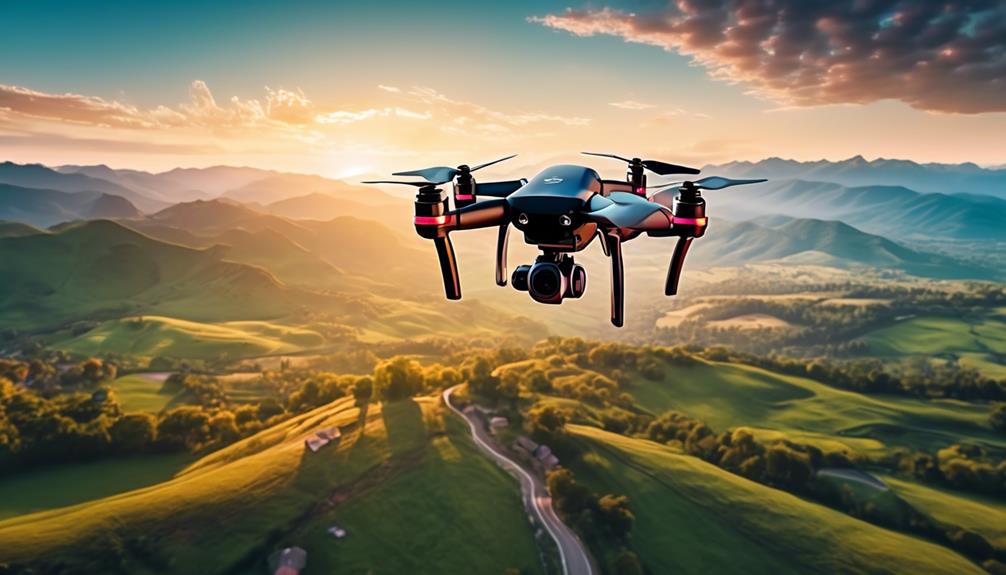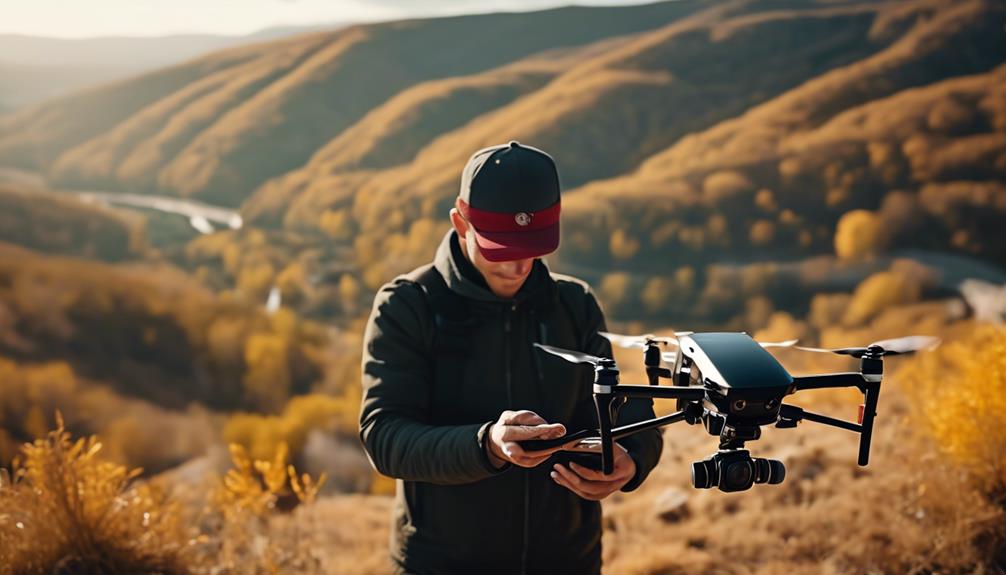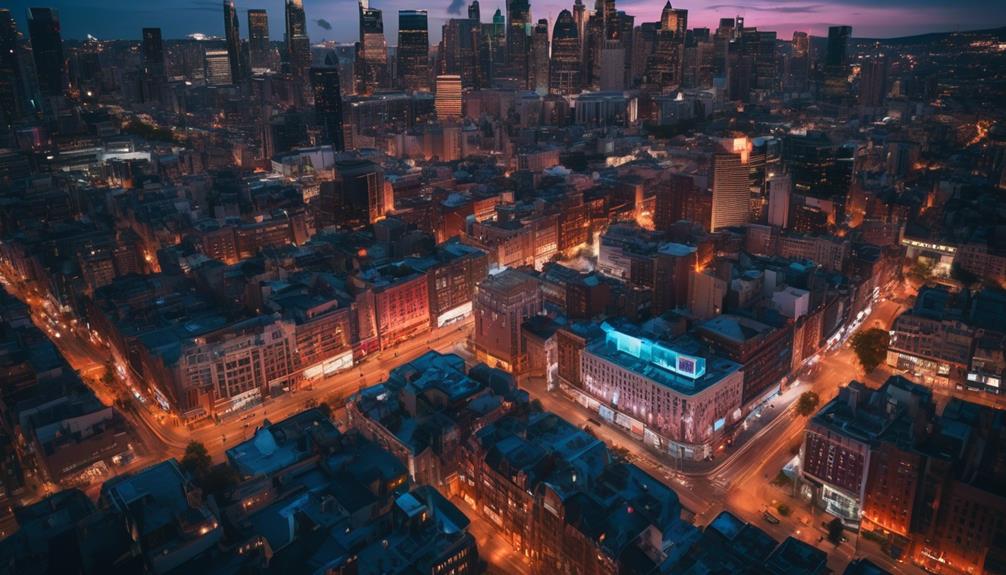Please note this post may contain affiliate links picked by me (Jay) that I have deemed may be of interest or relevant to you the reader of this.
These links do not affect the cost of the thing if you decide to purchase but i may get a little money if you choose to purchase.
For more information on my affiliate link policy click here.
You won't believe the incredible world of possibilities that awaits you when you take your first steps into aerial drone photography excellence. The ability to capture breathtaking shots from a bird's-eye view is truly a game-changer for any photographer.
But where do you begin? How do you navigate the vast sea of aerial drones, techniques, and equipment? Fear not, my fellow aspiring aerial photographers, for I am here to guide you through the maze of pixels and propellers.
From selecting the perfect aerial drone to mastering photography techniques, planning epic shots, and post-processing like a pro, this discussion will equip you with the essential knowledge to soar to new heights in your photography journey.
So, buckle up and get ready to elevate your skills to the next level. Let's embark on this aerial adventure together.
Key Takeaways
- Finding the right balance between functionality and specific photography needs is crucial when selecting an aerial drone for photography.
- Mastering aerial photography techniques, such as composition and experimentation with angles and perspectives, can unlock a whole new world of creativity and perspective.
- Having the essential equipment, including a high-quality camera, filters, gimbal, and accessories, is essential for capturing stunning aerial drone photography.
- Planning and executing successful aerial shots involves checking weather conditions, finding unique perspectives, experimenting with heights and angles, and incorporating creative composition techniques.
Selecting the Right Aerial Drone
When it comes to selecting the right aerial drone, I can't stress enough the importance of finding the perfect balance between functionality and your specific photography needs. The world of drones is constantly evolving, with new models boasting innovative features that can elevate your aerial photography to the next level. But before you get swept away by the allure of cutting-edge technology, it's crucial to consider your own requirements.
First and foremost, think about the features that are essential for your photography goals. Do you need a drone with a high-quality camera that can capture stunning images and videos? Or perhaps you prioritize stability and maneuverability for capturing smooth shots? Whatever your priorities may be, make a list of the must-have features that align with your vision.
But it's not just about the features; drone maintenance is equally important. While drones are designed to be durable, regular upkeep is necessary to ensure optimal performance. Cleaning the propellers, checking the battery life, and inspecting the motors are just a few maintenance tasks that should be part of your routine.
In the world of aerial drone photography, selecting the right drone is a crucial first step. By considering the features that align with your photography needs and prioritizing proper maintenance, you can set yourself up for success in capturing breathtaking images from new heights.
Mastering Aerial Photography Techniques
I have discovered that mastering aerial photography techniques is like unlocking a whole new world of creativity and perspective. It's not just about capturing stunning images from the sky; it's about telling a story and evoking emotions through your photographs. To achieve this, composition techniques play a crucial role.
One technique is the rule of thirds, where you divide your frame into nine equal parts and place your subject along the intersecting lines. This adds balance and visual interest to your images. Another technique is leading lines, which guide the viewer's eye towards the main subject, creating a sense of depth and movement. Experimenting with different angles and perspectives can also result in captivating shots.
But what happens when the weather doesn't cooperate? Capturing aerial photography in challenging weather conditions requires careful planning and preparation. Strong winds can make it difficult to control your drone, so it's essential to choose a calm day for optimal results. Fog and mist can add a mystical atmosphere to your images, while rain can create unique reflections. However, make sure your drone is waterproof and take precautions to prevent water damage. In low light conditions, such as sunrise or sunset, adjust your camera settings to capture the beautiful golden hour light.
Mastering aerial photography techniques is an ongoing journey of exploration and innovation. By incorporating composition techniques and learning to adapt to challenging weather conditions, you can elevate your aerial photography to new heights.
Essential Equipment for Aerial Drone Photography
To capture stunning aerial drone photography, having the right equipment is essential. And when it comes to drone photography, the right accessories can make all the difference. These accessories not only enhance the capabilities of your drone but also allow you to experiment with aerial composition in ways you never thought possible.
One of the most important drone accessories is a high-quality camera. After all, you want your aerial shots to be sharp, vibrant, and full of detail. Investing in a camera that can capture high-resolution images and videos will take your drone photography to the next level.
Another must-have accessory is a set of filters. Filters can help you control the amount of light entering the camera, allowing you to achieve the perfect exposure for your shots. They can also enhance colors and reduce glare, giving your photographs that professional touch.
For those who want to take their drone photography to new heights, a gimbal is a game-changer. A gimbal stabilizes your camera, ensuring smooth and steady footage even in windy conditions. This is particularly important when capturing aerial videos, as shaky footage can ruin the overall quality of your work.
Planning and Executing Successful Aerial Shots
Now that we've all the essential equipment for capturing breathtaking aerial drone photography, let's dive into the exciting world of planning and executing successful aerial shots.
One of the first things to consider when preparing for a drone photography session is the weather conditions. It's crucial to check the forecast and ensure that the wind speeds, rain, or other adverse weather elements won't interfere with your flight. Clear skies and gentle winds are ideal for capturing stunning aerial shots.
Once you've got the weather sorted, it's time to think about finding unique aerial perspectives. The beauty of drone photography lies in the ability to capture angles and viewpoints that are otherwise impossible. Look for interesting landmarks, patterns, or textures that will make your shots stand out. Experiment with different heights and angles to create a sense of depth and dimension.
Don't be afraid to get creative and think outside the box. Sometimes, the most captivating aerial shots come from unexpected angles or compositions. Look for ways to incorporate leading lines, symmetry, or framing techniques to add visual interest to your photographs.
Post-Processing Tips for Stunning Aerial Images
Enhance the beauty of your aerial images with these expert post-processing tips.
After capturing breathtaking shots with your aerial drone, it's time to take your images to the next level through color correction and enhancing details.
Here are three essential post-processing techniques that will make your aerial images truly stunning:
- Color Correction: Adjusting the colors in your aerial images can dramatically improve their visual impact. Use software like Adobe Lightroom or Photoshop to fine-tune the white balance, saturation, and vibrancy. Experiment with different color grading techniques to achieve the desired mood and atmosphere.
- Enhancing Details: Aerial images often capture intricate textures and patterns that can be further enhanced during post-processing. Utilize sharpening tools to bring out the fine details, making your images sharper and more defined. Adjusting the clarity and contrast can also help accentuate the textures and create a more dynamic composition.
- Graduated Filters: To balance the exposure in your aerial images, consider using graduated filters during the post-processing stage. These filters allow you to darken the sky while maintaining proper exposure for the landscape below. This technique can add depth and drama to your images, creating a more captivating visual experience.
Frequently Asked Questions
How Do I Obtain a License to Fly a Drone for Aerial Photography?
To obtain a license for flying a drone and capturing stunning aerial shots, there are a few steps you'll need to take.
First, research the drone license application process in your country to understand the requirements and regulations.
Next, consider enrolling in drone pilot training programs to gain the necessary knowledge and skills. These programs will teach you about flight safety, regulations, and photography techniques to help you excel in the world of aerial drone photography.
What Are the Legal Restrictions and Regulations I Should Be Aware of When Flying a Drone for Aerial Photography?
When it comes to drone photography, it's essential to be aware of the legal restrictions and regulations. These rules ensure the safety of everyone involved and protect the airspace.
Before taking to the skies, familiarize yourself with the drone photography legality and the regulations in your area. Check for any required licenses or permits, flight altitude limitations, no-fly zones, and privacy concerns.
How Can I Ensure the Safety of My Drone and Camera Equipment While Flying?
When it comes to ensuring the safety of my drone and camera equipment while flying, there are a few key things I always keep in mind.
First, regular drone maintenance is crucial. Checking the propellers, battery, and firmware updates are essential to keep everything in top shape.
Second, proper equipment storage is essential to protect my gear from damage. Investing in a sturdy case or backpack specifically designed for drones can help prevent any accidents while on the go.
Safety and maintenance go hand in hand to ensure a smooth and successful flight every time.
Are There Any Specific Weather Conditions I Should Avoid When Planning Aerial Shots?
When it comes to aerial drone photography, there are definitely some weather conditions you want to avoid. Trust me, I've learned the hard way. Strong winds can make it nearly impossible to keep your drone steady, resulting in shaky and blurry shots.
Rain and snow are also a big no-no, as they can damage your equipment.
The best times for aerial shots are during the golden hour, right after sunrise or before sunset, when the lighting is simply magical.
What Are Some Creative Composition Techniques I Can Use to Capture Unique and Visually Appealing Aerial Photographs?
When it comes to capturing unique and visually appealing aerial photographs, there are a couple of composition techniques that can really make your shots stand out.
One technique is using leading lines, which can guide the viewer's eye through the image and create a sense of depth.
Another technique is the rule of thirds, where you place the main subject off-center to add interest and balance.
These techniques can take your aerial photography to the next level and help you capture truly stunning shots.
Conclusion
So there you have it, my friend. With the right drone, some mastery of photography techniques, essential equipment, and a solid plan, you're well on your way to capturing breathtaking aerial shots.
Just remember, like a bird soaring through the sky, your images have the power to transport viewers to new heights of awe and wonder.
So go out there, spread your wings, and let your creativity take flight!


